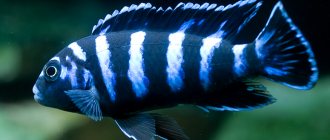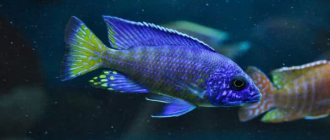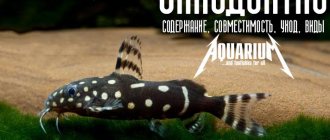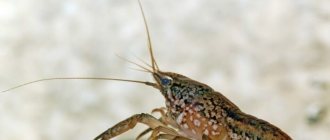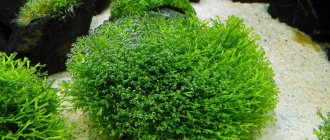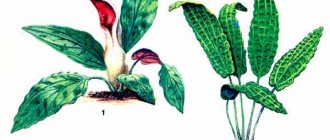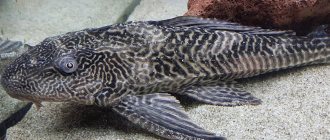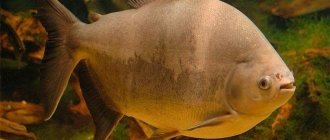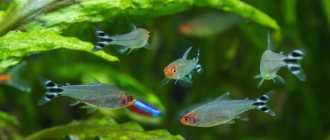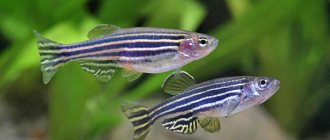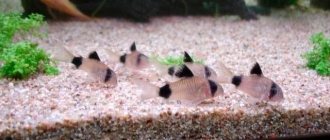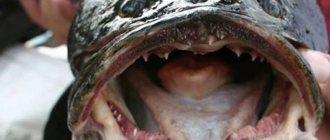Polypterus are rare fish with spines instead of a dorsal fin and a long elongated body covered with durable diamond-shaped scales. According to rough estimates, they have existed for about 60 million years and have changed little during this time.
| Full name | Polypterus/Polypterus |
| Kinds | Endlichera, Senegalese, delgesi, ornatypinis, albino, uixia, lapradi, bichir |
| Color | Gray, beige with dark splashes or patterns |
| Water | PH (acid-base balance) – 6-8 KH (hardness) – 5-25 t (temperature) – 24-30 0C |
| Dimensions | Up to 40 cm in an aquarium, up to 90 cm in natural conditions |
| Water volume (liter) / 1 individual | From 200 l/1 individual |
| Feed | Live food: insects and their larvae, worms, shellfish, small fish Dry food: TetraWaterMix bottom fish tablets, TetraMinXLGranules sinking granules, TetraCichlidSticks floating sticks for cichlids |
| Compatibility | African Great Lakes cichlids, butterflyfish, black knives, synodontis, astronotus, metinis, giant gouramis, shark barbs |
| Priming | Small river pebbles, soft sand |
| Plants | Any |
| Scenery | Large stones, driftwood, ceramic pipes, long pots |
| Lifespan | From 10 years |
Description and historical background
Polypterus are indeed similar in their existence on Earth to dinosaurs; they appeared more than 60 million years ago.
This strange lungfish is native to the ancient African continent and is often called Nile dragons.
Polypterus belongs to the family of multifinned freshwater fish. Multifinned means that the dorsal fin is divided into individual ridge-like appendages.
The body of Polypterus is long, serpentine. The pectoral fins are also amazing, formed by two bones with dividing cartilage. They are long and strong and help the fish push off from the bottom - its swimming method is very unusual. Relying on them, the multifeather also rests and moves on land.
Other distinctive features also indicate its ancient origin, dating back to the Cretaceous period of the planet’s development. These are large and very durable scales and large nostrils, a skeleton formed by cartilage (like those of sharks or rays), and an unusual arrangement of cranial plates.
The swim bladder of Polypterus is modified and, in its functional characteristics, is more reminiscent of a lung. Therefore, this fish can breathe atmospheric air and spend quite a long time out of water and in reservoirs where there is little oxygen.
The first natural scientific descriptions of multi-pinnate fish appeared at the beginning of the 19th century.
The French biologist Georges Cuvier named one of the species of polypterus senegalus; it is this species that is most widespread in the aquarium hobby and is often called Cuvier's polypterus. This fish has intelligence - it is able to remember people and recognize its owner.
In 1859, the Dutch scientist Peter Blecker identified these fish as a separate order of Polypinidae and proved that they are one of the oldest representatives of the Earth's fauna.
Polypterus still lives in water bodies in Africa - in the Nile River basin, Lake Chad, India, and Southeast Asia. Senegal, Nigeria, and Gambia are also native habitats; the multifin is often found in numerous bodies of water in these countries.
In nature, the multiply reaches 70 cm or more in length, and in aquarium conditions it grows to 35-45 cm. Unique specimens in the wild are known, weighing more than 100 kg.
Photo gallery of polypterus:
In many countries, polypterus meat is considered a delicacy and is served in restaurants and sushi bars at incredible prices.
This is a predator that is nocturnal. Polypterus sees poorly, but its sense of smell is superior in sensitivity to many mammalian animal species.
Mr. Tail recommends: Polypterus varieties
The multifeather has two subspecies:
- Erpetoichthys - it includes only Kalamoichthys calabar.
- Polypterus - has more than 10 species.
Kalamoichta calabarica
This amazing fish is often called the Chinese dragon.
The long body (up to 90 cm in natural conditions) is very similar to a snake. But the kalamoicht moves in the water with such speed and wraps itself around plants that its movements are more reminiscent of flight or an intricate dance.
In artificial reservoirs, these greenish dragons with bright orange fins rarely grow to 45 cm.
Polypterus congolese
Ornatipinus or marbled dragons are distinguished by their large size (up to 45 cm), high aggressiveness and peculiar coloring - there are numerous white markings on a black or dark brown background.
You can see them only during feeding; the rest of the time they prefer to hide in grottoes or bury themselves in the bottom filler.
They require a large artificial reservoir - at least 450 liters for 2-3 individuals with water at a temperature of +23...+28 ºC, pH 6.5-8.5, 7-26 °dH.
Tiger polypterus
Tiger Polypterus Endlicheri Bichir is very large - up to 75 cm. The main background of the long body is grayish-bluish. It has wide dark transverse stripes.
This strong nocturnal predator is very slow in its native habitat (African water bodies), but in its artificial habitat it is highly active. An aquarium must have a volume of at least a thousand cubic meters and must be fed with live food.
Optimal housing conditions are the same as for marble dragons.
Polypterus Uixia
These gigantic multi-feathers reach a length of 90-100 cm. It is difficult to find a home aquarium for them; they are sometimes found in aquariums. They are distinguished by a bluish, long, spindle-shaped body with transverse stripes of a darker color.
Polypterus Delgesi
Polypterus delhezi are extremely brightly colored. The long body is gray or grayish-olive in color, mottled with stripes and spots. Maximum size up to 35 cm.
This nocturnal predator is almost never seen in the aquarium during the day.
The optimal keeping conditions for this multi-feather will be an environment with water parameters - temperature +24...+28 °C, hardness about 5.5-8.5 °dH, pH 6.5-8.5.
Polypterus senegalese
Polypterus Cuvier has become the most widespread in home aquarium keeping.
This large fish has a fairly peaceful character and is highly active.
In appearance it is not particularly bright and resembles an eel. The maximum body length is 35-40 cm, but in natural conditions it grows up to 75 cm.
The main background of the body is blue-gray or grayish-blue, and the belly is light. Among the representatives of this species there are also albino individuals.
Popular types
About 10 varieties of Polypterus are known, many of which are suitable for aquarium life.
Polypterus senegalese
The most common of all polypterus, growing up to 40 cm. Senegalese polypterus has 8-12 spines on the dorsal fin and is colored silver-gray with a bluish tint. The sides and belly of the fish are light. Young animals have 3 dark longitudinal stripes on their sides, which disappear as they grow older. Senegalese polypterus has a non-aggressive, curious character and is suitable for keeping in home aquariums.
Polypterus Endlicher
The multi-feather has a second name - tiger and in nature grows up to 50-75 cm. It has a flat, elongated body and fleshy pectoral fins that help move in space. The upper mouth of Polypterus is stretched in a characteristic “smile”, and the scales are colored brown with dark vertical stripes of irregular shape. The head and fins of the fish are covered with small black spots.
Polypterus delgesi
A relatively small fish, no more than 35 cm long. The body of Polypterus Delgezi is colored in a light olive shade and strewn with dark spots of arbitrary shape. The belly is yellowish. The dorsal fin of the fish is formed by 8-10 rays, and the caudal fin has a pointed shape.
Polypterus ornatypinis
The species has a second name - motley or Congolese and is endemic to the Congo River basin and Lake Tanganyika. Ornatypinis grows up to 60 cm and has 9-11 spines on its back. The fish has a very interesting coloring. The gray-brown back is decorated with marble patterns, and there is a mesh pattern on the head. The abdomen is yellow.
This is interesting! Unlike other species, Ornatypinis is an active predator and stalks its prey. It feeds on invertebrates and medium-sized fish.
Senegalese albino
A variety of Senegalese polypterus. It differs from it only in its white color, acquired due to its bottom-dwelling lifestyle.
Wixia
It is considered the largest of all multi-feathers and grows up to 90 cm. Its powerful spindle-like body is gray in color with dark stripes. Although Polypterus Uixia has a calm disposition, it is extremely rarely kept in captivity due to the difficulties in choosing an aquarium.
Lapradi
A relatively small fish, growing up to 40 cm. It is colored greenish-gray with numerous black spots and has a yellowish dorsal fin.
Bishir
The polygonum is also known as the Nile and is endemic to the Nile River. It grows up to 50 cm and lives for about 10-15 years. The upper part of the fish's body is colored in shades of gray, olive and green. The abdomen is light.
Care and maintenance of Polypterus in a home aquarium
The main difficulty in keeping polypterus in an artificial home pond is the large size of the aquarium. Since even the smallest varieties of snakefish rarely reach a size of less than 30 cm, they are usually larger. But the depth in this case does not matter, so you can choose not very high, but long and wide tanks.
The minimum sizes that can suit water dragons are 120 by 40 cm or 180 by 60 cm.
The top of the reservoir can be covered with a special lid or mesh, but it should be remembered that multi-feathers need atmospheric air. But protection against being thrown from a body of water is still necessary. The multi-feather will be able to live for some time on the floor, but it still suffers greatly from dryness and most often this ends in loss of vision.
Fish snakes have a hard time getting along with their neighbors; they even often fight with their relatives over food.
However, polypterus spend most of their time at the bottom, burrowing into the ground. They also eat at the bottom of the aquarium. Therefore, the best filler would be small fractions of river pebbles or sand.
Many-feathers do not eat aquatic plants, but they like to hide in their thickets and look unusually beautiful there. Water moss and algae with hard, wide, durable leaves are suitable.
It is also necessary to provide large shelters; they can be made from driftwood, stones, and other decorative elements. It is only necessary to avoid sharp edges and any surfaces that could injure the fish. Polypterus are characterized by unexpected “jumps”.
Filtration and aeration are also necessary, but moderate. Multifeathers do not litter much and often breathe atmospheric air.
The ideal parameters of the aquatic environment for polypterus are a temperature from +23 °C to +30 °C, a fairly soft environment that is closer to neutral in acid-base balance.
Part of the water must be replaced daily with fresh, settled water.
Strong lighting is not needed; these nocturnal predators love twilight and during the day they hide in thickets of plants or in decorative shelters.
Various uses of the plant
Photo: Beautiful Turcha marsh
- The species is used in folk medicine to treat diseases, including heart problems.
- The seeds are characterized by a lack of innate dormancy, the ability to remain viable after drying, and the ability to germinate in a relatively wide range of temperatures in light and an aerobic environment, making the feather an easy species to propagate.
- Oxygenating plants are a good solution for keeping your pond water clean and healthy. They produce and restore oxygen necessary for the life of fish and the breakdown of organic substances by bacteria. These include hotonia. Its leaves are not only oxygenators, but also a refuge for fish and various small aquatic organisms.
- The flower extract of the plant is included in homeopathic medicines. For example, “Water is purple.” This is a flower essence for people who tend to be aloof and closed off, appear cold and keep their problems to themselves. Prescribe 10 drops orally 3 times a day. Directions for use: Take 2 drops in a small glass of water and swallow at regular intervals or place directly on tongue.
Turcha is an excellent choice for your home aquarium. The wide growth habit makes the species suitable for planting between very short and tall plants. Chotonia can be pruned to create a distinctive median shrub in an aquascape, where its feathery, snowflake-like bright green foliage provides an unusual contrast to other species. This is often used in Dutch style layouts. As you can see in the photo, the Turcha plant decorates the aquarium with its bright appearance.
Feeding
Due to their high gluttony and indiscriminate eating habits, Polypterus are often called Siamese catfish and sea sharks.
You can feed them live, frozen, dry ready-made food. Suitable:
- bloodworm;
- tubifex;
- finely chopped veal;
- beef heart;
- sea and live river fish;
- dry mixtures for predators in limited quantities.
The main requirement for the diet is a high protein content. In addition, polyfins cannot eat from the surface of the water; pieces of food must necessarily sink to the bottom.
Pangasius will not eat even in high light conditions; they need twilight.
If the multifeathers have reached an advanced age (7-10 years), then their sharp teeth wear down and then it’s time for plant food:
- finely chopped lettuce, spinach, dandelion leaves;
- pieces of zucchini;
- grated cucumbers;
- porridge;
- boiled mashed potatoes.
Nutrition
Before feeding Polypterus delgesi, it is worth finding out what it eats in the wild. This species is predatory, and it is not recommended to add smaller fish to them in the aquarium. The main diet for him is food high in protein. It may consist of earthworms, squid, plankton and shrimp. But before you feed Polypterus delgesi, you need to know the fact that 5 percent of plant food should still be in its diet. It is not necessary to stock the aquarium with algae, but plant pelleted food should be added to the daily diet. In addition to frozen food and substrate, it is recommended to periodically feed this fish live food. Fry, bloodworms and small worms are suitable for this purpose. For adults, feeding twice a week is sufficient. It is noteworthy that Polypterus has poor eyesight, but over time it is able to identify its owner by silhouette.
Compatibility and behavioral characteristics
Young polypterus prefer to live in flocks, but as they grow older they switch to a solitary lifestyle.
The Senegalese polyfin, which most often lives in aquariums, is quite peaceful and is able to get along with some large species of predatory cichlids. But the water dragon will definitely mistake small fish for food and destroy them.
Large specimens of fish are more or less able to get along with Polypterus:
- barb;
- knife fish;
- labeo;
- cichlids;
- Akara;
- astronotus;
- iris;
- gourami.
You should not add sucker catfish to shark dragons; their immobility irritates the multi-feathers.
Sometimes polypterus pounce and bite even fish that are larger than them, apparently this is due to blurred vision. But when the owner approaches an artificial reservoir, polyfins always react violently - they swim up to the front wall of the aquarium and begin to fuss. Accustomed individuals are even capable of eating from a human hand.
Some professionals often suspect multi-feathers of sentimentality. When frightened, they “faint.” In fact, such freezing or the image of a dead body is nothing more than an attempt to hide from an imaginary danger.
Most often, “loss of consciousness” occurs when the body of water changes, the lighting is too bright, or the temperature-salt balance is disturbed.
In this case, the conditions of detention must be immediately adjusted, and the polypterus will quickly get used to the new environment. Usually after 30, maximum 40 minutes, the pretender “comes to life” and begins to settle down.
Compatibility with other fish
In terms of compatibility, the most important parameter is the size of neighboring individuals. The fish should be the same size. The following species will be good friends for polypterius:
- apteronothus;
- shark barbs;
- butterfly fish;
- giant gourami;
- astronotuses;
- cyclides are large;
- Indian knives;
- African cancers.
Young polyfins can be kept in a small school, but for adult fish such keeping is unacceptable. Sometimes adults can attack waterfowl that are larger than them, but such situations do not happen out of malice, but due to poor eyesight.
In terms of compatibility, the most important parameter is the size of neighboring individuals.
Breeding
Sexual differences between male and female polygons are subtle and only a specialist can understand them. Males have a wide, spade-shaped anal fin and a medium-sized head, while the female has a narrow and pointed rear plumage, and the upper part is more massive.
For spawning and artificial propagation of polypterus, special conditions must be created, and the aquarist must have sufficient experience.
The following can be considered as stimulating factors simulating the natural rainy season:
- slight softening and acidification of the aquatic environment;
- increase in water temperature by a couple of degrees.
If spawning occurs, then the most likely time is July-October.
The established pair swims side by side, touching their bodies, biting each other’s fins.
Surprisingly, the female lays eggs only in the “hands” of the male. The male folds his pectoral fins in a certain way so that it looks like a bowl, and takes valuable cargo into it. Then it independently and evenly distributes the eggs on the surface of aquatic plants.
If the owner wants to preserve the offspring of polyptersus, then the adult individuals now need to be removed.
After 5-7 days, the eggs hatch into fry. They are aggressive from the first days of life and in order to prevent cannibalism, they must be periodically sorted by size and seated.
In order for small multi-feathers to develop well, the water must be diluted very often with fresh portions and aeration must be increased.
The fry begin to be fed a week after hatching. The first food is usually Artemia naupelia. When the body size of the multifeathers reaches 5-6 cm, they are transferred to adult feeding.
Haplochromis boazulu
Haplochromis boadzuluHaplochromis boadzulu - Cyrtocara boadzulu
Comfortable water parameters for keeping: 25-27°C, dH 8-20°, pH 7.5–8.5, aeration, filtration, weekly replacement of 1/3 of the water with fresh water. Habitat: rocks near the island. Boadzulu. The length of the fish in the aquarium reaches up to 12 cm. Color: the body is shiny blue, especially in the front, the back half of the body has orange spots. The fins have gray-blue tones. The dorsal fin has an orange border. The fish are relatively peaceful and can be kept in a community aquarium of 100 liters or more. (for a couple). Peaceful cichlids can be neighbors.
Feeding aquarium fish should be correct: balanced, varied. This fundamental rule is the key to the successful keeping of any fish, be it guppies or astronotuses. The article “How and how much to feed aquarium fish” talks about this in detail; it outlines the basic principles of the diet and feeding regime of the fish.
In this article, we note the most important thing - feeding fish should not be monotonous; the diet should include both dry food and live food. In addition, you need to take into account the gastronomic preferences of a particular fish and, depending on this, include in its diet food either with the highest protein content or, conversely, with plant ingredients.
Haplochromis boazulu
Popular and popular food for fish, of course, is dry food. For example, you can constantly and everywhere find food on aquarium counters - the leader of the Russian market; in fact, the range of food for this Tetra is included as individual food for a specific type of fish: for goldfish, for cichlids, for loricariids, guppies, labyrinths, arowanas, discus, etc. .d. Tetra has also developed specialized foods, for example, to enhance color, fortified, or for feeding fry. You can find out detailed information about all Tetra feeds on the company's official website - here.
It should be noted that when purchasing any dry food, you should pay attention to the date of its manufacture and shelf life, try not to buy food in bulk, and also store the food in a closed state - this will help to avoid the development of pathogenic flora in it. All of the above is just the fruit of observing this type of aquarium fish and collecting various information from owners and breeders
We would like to share with visitors not only information, but also live emotions that allow us to understand the world of aquariums more fully and subtly. Register at https://fanfishka.ru/forum/, participate in discussions on the forum, create profile topics where you will talk about your pets in the first person and from the horse’s mouth, describe their habits, behavior and content, and share with us your successes and joys, share your experiences and learn from the experiences of others. We are interested in every bit of your experience, every second of your joy, every awareness of a mistake, which makes it possible for your comrades to avoid the same mistake. The more of us, the more pure and transparent drops of goodness in the life and everyday life of our seven billion society
All of the above is just the fruit of observing this type of aquarium fish and collecting various information from owners and breeders. We would like to share with visitors not only information, but also live emotions that allow us to understand the world of aquariums more fully and subtly. Register at https://fanfishka.ru/forum/, participate in discussions on the forum, create profile topics where you will talk about your pets in the first person and from the horse’s mouth, describe their habits, behavior and content, and share with us your successes and joys, share your experiences and learn from the experiences of others. We are interested in every bit of your experience, every second of your joy, every awareness of a mistake, which makes it possible for your comrades to avoid the same mistake. The more of us there are, the more pure and transparent drops of goodness there are in the life and everyday life of our seven billion society.
Video Haplochromis Boadzulu
+
Diseases and prevention
Despite certain difficulties in organizing the aquarium keeping of polypterus, these fish are quite picky about environmental conditions and rarely get sick.
But with significant violations of care parameters, some pathologies may still arise:
- Obesity. This is the scourge of fish that suffer from overeating. Therefore, it is important to monitor your diet and portion sizes.
- Monogeny infection. This disease is manifested by poor appetite and even a complete refusal to eat, frequent and convulsive breathing (for this purpose, multi-feathers often rise to the surface of the water), and standing motionless on the ground. Monogenies are small worms that reproduce on the body and especially the head of large fish. Azipirin is used for treatment.
- Damage by freshwater leeches. Only individuals brought from their natural habitat can be infected with this disease. But to be on the safe side, it is necessary to quarantine any acquired polyfins before introducing them into a home aquarium.
- Injuries. Despite their frightening appearance, multifin sharks are very timid and often turn around sharply, hit the walls of the aquarium, and try to jump out of the water. Therefore, the tank should be placed in a quiet and peaceful place, protected from noise and bright light.
- Ammonia poisoning. This disease occurs when water stagnates in an artificial reservoir.
Reproduction
Reproduction in nature occurs between August and September. In aquarium conditions, spawning can be stimulated by frequent water changes, lowering the pH level to 6.5 and adding 1% potassium iodide (1 drop per 10 liters of water). It is very interesting to watch mating games. The male directly dances around the female, entwining her.
The female lays eggs on the leaves of plants. If the water temperature is at least 26 C, then after 4 days the larvae hatch.
The fry need to be sorted, as the larger ones begin to eat the smaller ones.
Specimens that are most often sold are wild-caught. Therefore, purchased specimens must be quarantined before being introduced into the aquarium.
Sex differences
It is difficult to visually determine where the female is and where the male is. However, it is possible to distinguish males by their large and thickened anal fin.
Interesting Facts
This ancient fish attracts very high interest from scientists all over the world, so it is usually one of the main curiosities of demonstration aquariums and oceanariums.
Polypterus are one of the most common fish for photography and video shooting. That’s why the habitats of multi-feathers always attract photographers. But back in the early 20th century, photographs of these relict fish were sold very expensively.
The intelligence of an underwater dinosaur is amazing - it really recognizes its owner and even daytime sleep can be interrupted so that a loved one feeds and caresses the pet.
Under conditions of high humidity (the body must always be wet), polypterus can remain on land for a long time. For example, a many-feathered dragon can track prey on the shore for up to 6-7 hours.
Pulmonary respiration in polypterus develops gradually and does not appear at birth. Therefore, external gills grow on the head of fry up to 2-3 months, which makes them somewhat similar to axolotls.
